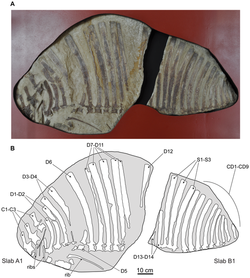| Ctenosauriscids Temporal range: Early-Middle Triassic, | |
|---|---|
 | |
| Vertebrae of the ctenosauriscid Ctenosauriscus koeneni | |
| Scientific classification | |
| Domain: | Eukaryota |
| Kingdom: | Animalia |
| Phylum: | Chordata |
| Class: | Reptilia |
| Clade: | Archosauria |
| Clade: | Pseudosuchia |
| Clade: | † Poposauroidea |
| Family: | † Ctenosauriscidae Kuhn, 1964 |
| Genera | |
Ctenosauriscidae is an extinct family of pseudosuchian archosaurs within the clade Poposauroidea. [1] Ctenosauriscids existed in Africa, Asia, Europe and North America during the Early Triassic to the Middle Triassic period (latest Olenekian to Anisian stages). [1] All species had large "sails" on their backs. Ctenosauriscids are among some of the earliest archosaurs and represent the first global radiation of the group. [2]





